
 Han Chin Pet Soo (3 May, 2016)
Han Chin Pet Soo (3 May, 2016)
Han Chin Pet Soo (GPS: 4.59629, 101.07904) is a Hakka tin-miners' clubhouse in Ipoh that is today converted into a museum. It was established by the Hakka tycoon Leong Fee in 1893 and occupies the townhouse belonging to him. The name Han Chin Pet Soo means "entertainment and leisure villa". The original building was later renovated with an addition storey added in 1929, becoming the three-storey townhouse that we see today. It is the oldest Chinese club in Ipoh.
Contact
For any enquiries, please contact IpohWorld at +60-5-547 1689 (Research Office) and +60-5-241 4541 (Han Chin Pet Soo Museum).About Leong Fee, the founder of Han Chin Pet Soo
Born in Meixian District in Guangdong Province, China, in 1857, Leong Fee @ Liang Pi Joo, had arrived in Malaya a penniless young man in 1876. Disembarking from an old freighter at Weld Quay in George Town, Penang, he moved about, taking on various odd job before moving on to Ipoh that same year, traveling by boat up the Kinta River via Teluk Intan (then known as Telok Mak Intan). He brought with him a spiritual tablet of the Chinese God of Properity, known in Cantonese as the Tai Pak Koong, and established a temple beside the Kinta River. The Tai Pak Koong River is still there today, albeit known as the Shue Yue Gong or Ipoh Kuan Yin Temple.Ipoh at that time was when fortunes were made, and the few immigrants who did not gamble away their wages, or spent it on booze and women, swiftly amassed much wealth. Starting as a clerk, Leong Fee eventually became a tin miner - and a successful one too - that by the late 1880s, he had become the among the richest men in all of Ipoh. At that time, Ipoh was a huddled mess of thatched houses, but the Great Fire of Ipoh of 1892 put paid to that, razing much was what was there. Some two hundred houses were destroyed in the blaze. This was however the impetus for the town to be rebuilt, and new roads were laid in a grid. By then, Leong Fee had rising to the upper echelons of Ipoh society, having been made a visiting Justice of Kinta in 18922 and was the first Chinese to sit on the Federal Legislative Council in 1902. Leong Fee was one of the first Chinese miners to introduce Western management and mining technology to the mines in the Kinta valley. He served as the Vice-Consul of the Chinese Government in Penang between 1901 and 1907.
After Leong Fee passed away in 1912, the property at 3 Jalan Bijih Timah (Treacher Street) was taken over by his son, Leong Yin Kean, who continued to maintain it along with the other Hakka tin miners including Lim Chang Jiu, Leong Jin Yuen, Leong Moon Chow, Leong Rui Dian, Pan Jing Ting and Sze Hua. To ensure that the property remained in the hands of the club members, Leong Yin Kean in 1927 sold it to them at below market price.
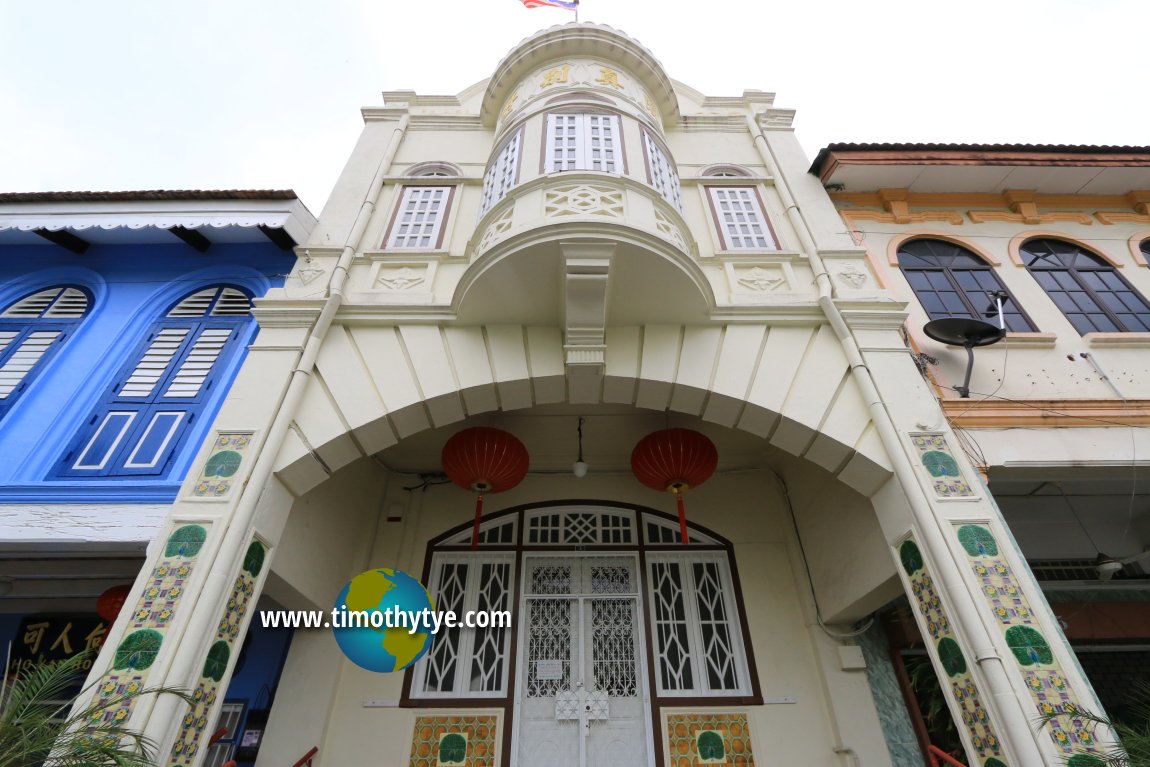 Han Chin Pet Soo (3 May, 2016)
Han Chin Pet Soo (3 May, 2016)
 Beautifully restored frontage of Han Chin Pet Soo (3 May, 2016)
Beautifully restored frontage of Han Chin Pet Soo (3 May, 2016)
 Side columns of the five-foot way bear tiles with floral and peacock motif. (3 May, 2016)
Side columns of the five-foot way bear tiles with floral and peacock motif. (3 May, 2016)
The present 3-storey Han Chin Pet Soo building dates from 1929, when the property underwent a massive renovation. A housewarming was held on 5 May, 1930, in conjunction with the 37th anniversary of its founding. It was one of the first buildings in Ipoh to be fitted with electric bulbs, as electricity has just been introduced to Ipoh that very year.
The Great Depression of the 1930s eroded the fortunes of some of the tin miners, but nothing compared to the calamity of Second World War. In 1941, in the chaos following Japanese invasion, Han Chin Pet Soo was illegally sold, without the knowledge of the members, who had to fight a legal battle to get it back. It was only in 1945 that they were able to claim the property back.
"Modernisation" in the 1960 introduced air-conditioning as well as unsympathetic renovations. In order to accommodate the air conditioners, the bay windows on the upper floor were removed.
Hakka tin miners continued to make use of Han Chin Pet Soo as their clubhouse right up to 2012. By then, most of the tin mines in Ipoh had closed or were exhausted, while the tin miners - those still living - were a mere shadow of their former selves. In the interest of preserving history, the club members decided to lease their premises to an organisation called itself IpohWorld. IpohWorld is operated by individuals who are passionate to celebrate Ipoh's past and to present it as accurately and as faithfully as it is possible.
IpohWorld spent much of 2014 restoring the Han Chin Pet Soo building, and managed to reopen it to the public in February 2015. By then, the property has been brought back to its former self - to be exact, not to 1893, but to what it was following the 1930 renovation.
Visitors to Han Chin Pet Soo may appreciate the museum quality exhibits that carefully details the history of tin mining in the Kinta Valley. There are interpretive boards as well as life-size dioramas that faithfully captures the lifestyle of the early 20th century Hakka tin miners, their way of life and their leisure pursuits.
 Han Chin Pet Soo in 2011. At that time, the Ho Yan Hor Museum next door has not open yet either. (18 June, 2011)
Han Chin Pet Soo in 2011. At that time, the Ho Yan Hor Museum next door has not open yet either. (18 June, 2011)
Layout of Han Chin Pet Soo
Han Chin Pet Soo is today a three-storey building. On the ground floor, immediately behind the front door, is the Members' Dining Room. The furnishing here is original, and dates as far back as 120 years, to the time of Leong Fee. Behind the dining room is the living quarters. There are exhibits here recreating a Chinese tin mine. Considering the club members are Hakka, there is also information of the Hakka people, their food, history and way of life.The first floor recreates the opium den, complete with life-size figurines of two opium smokers. The figurines were made in Ipoh, and particular attention is taken to ensure every figurine in the museum has a different appearance.
The front portion of the first floor is a parlour, with tables for the club members to entertain themselves over card games and mahjong. The club members may bring along their concubines or hired women to entertain them.
The second floor of Han Chin Pet Soo have two bedrooms which were once used as lodging place for visiting tin miners. The brass beds and camp beds are original dating back to the first half of the 20th century. Today one of the bedrooms have been renovated (in March 2018 itself) to showcase the old motorcars that were once used by the Chinese tin miners and European planters.
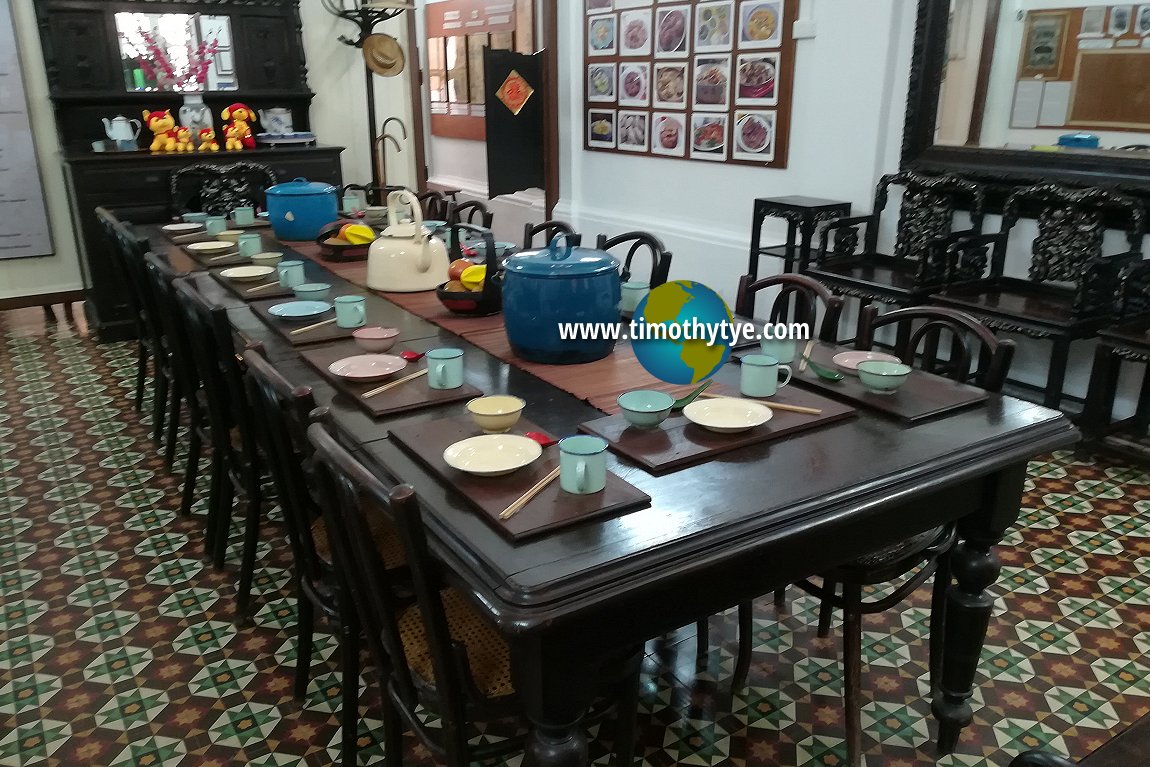 The dining room with dining table and tableware. (3 May, 2016)
The dining room with dining table and tableware. (3 May, 2016)
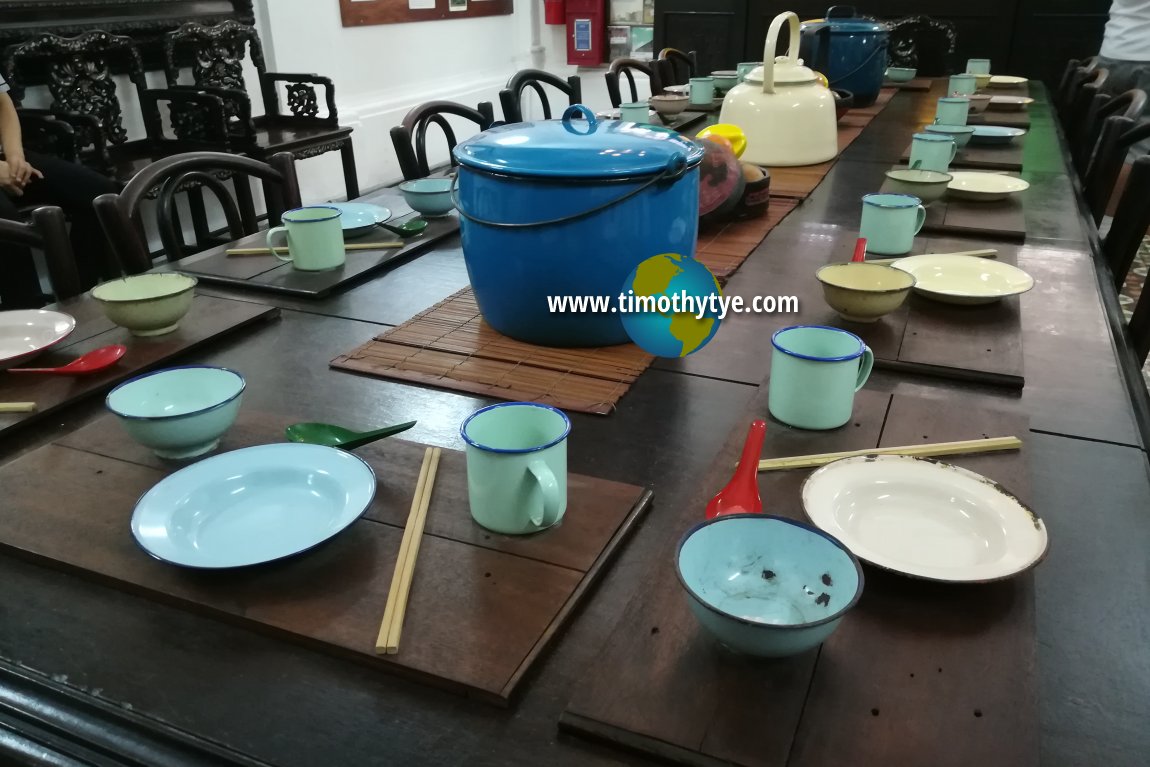 Another view of the dining table. (3 May, 2016)
Another view of the dining table. (3 May, 2016)
Visiting Han Chin Pet Soo
Visiting Han Chin Pet Soo is by appointment only. There are presently up to four scheduled appointments per day, with a maximum of 40 guests per appointment. Visitors are often taken around by inhouse guides who are well verse in the history of Han Chin Pet Soo and local tin mining. In the absence of a guide, visitors are encouraged to follow a numbered route. Photography is permitted, but visitors are requested to refrain from flash photography. Admission is free. Guests are encouraged donate to help upkeep of the building. Recommended amount to donate is RM10 per adult and RM5 per child and student.The restored Han Chin Pet Soo offers you a one-off chance to step back in time, to get a glimpse of how an opium den would look like, to "meet" the gamblers and their dancing girls and to experience a Kinta Valley tin mine. Advance bookings may be made through the IpohWorld website. There is also an opportunity to book at the door on a first come first served basis, however early booking is advised to avoid disappointment.
There is also the unique opportunity, depending on the numbers, to book the building as a movie set, for private functions such as themed lunches or dinners, corporate events or wedding photography etc.
 On the ground floor is a mini theatre where the history of Han Chin Pet Soo is screen. The bed is original. (3 May, 2016)
On the ground floor is a mini theatre where the history of Han Chin Pet Soo is screen. The bed is original. (3 May, 2016)
 Kitchen utensils and other tools. (3 May, 2016)
Kitchen utensils and other tools. (3 May, 2016)
 The kitchen cupboard. (3 May, 2016)
The kitchen cupboard. (3 May, 2016)
 Display showing Hakka woman working in the actual kitchen of Han Chin Pet Soo. (3 May, 2016)
Display showing Hakka woman working in the actual kitchen of Han Chin Pet Soo. (3 May, 2016)
 The ore that is mined is weighed, and the value calculated by a clerk before it is sent to D.K.S (Dato Kramat Smelting) in Penang. (3 May, 2016)
The ore that is mined is weighed, and the value calculated by a clerk before it is sent to D.K.S (Dato Kramat Smelting) in Penang. (3 May, 2016)
 This is how the buckets of tin ore would have looked like. (3 May, 2016)
This is how the buckets of tin ore would have looked like. (3 May, 2016)
 Mural of a tin dredge to show the life of the Chinese tin mining coolies. (3 May, 2016)
Mural of a tin dredge to show the life of the Chinese tin mining coolies. (3 May, 2016)
 Mural depicting a five-foot way common in Ipoh and most of the towns in Peninsular Malaysia. (3 May, 2016)
Mural depicting a five-foot way common in Ipoh and most of the towns in Peninsular Malaysia. (3 May, 2016)
 Bags - or should I say sacks - of tin ore are weighed. (3 May, 2016)
Bags - or should I say sacks - of tin ore are weighed. (3 May, 2016)
 A clerk does the calculations on an abacus. (3 May, 2016)
A clerk does the calculations on an abacus. (3 May, 2016)
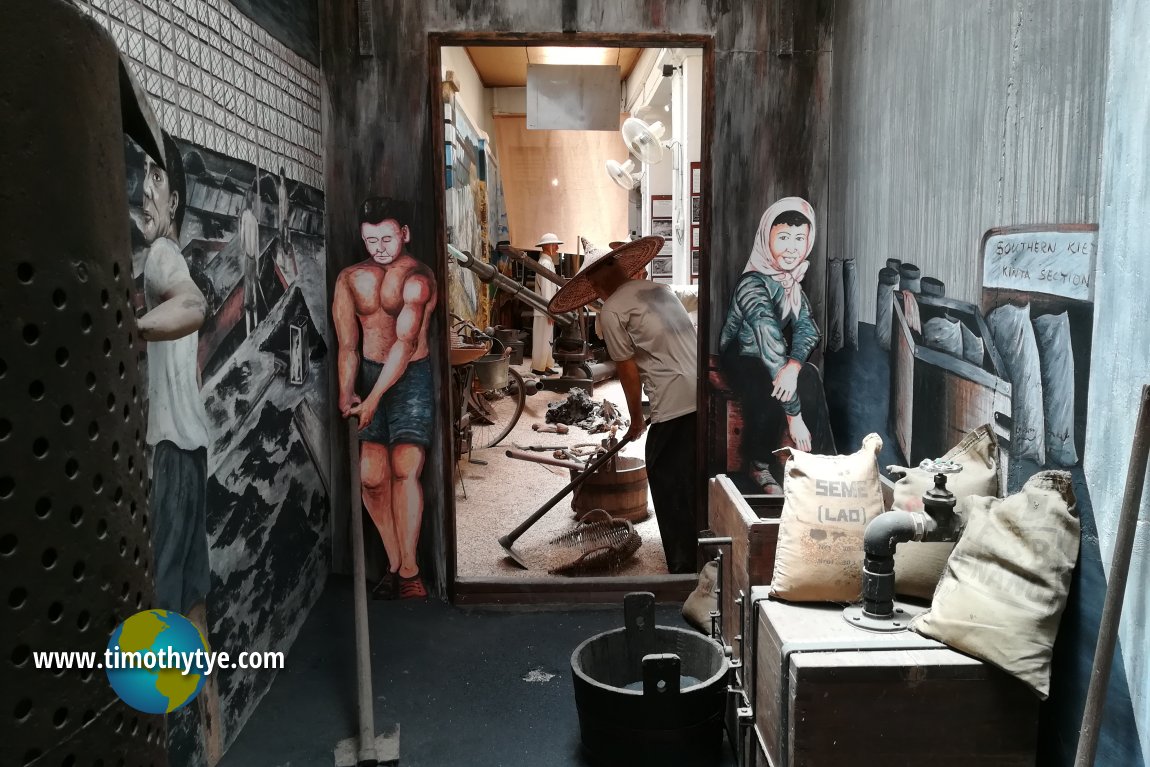 Tin mining in the Kinta Valley is depicted using life-size dioramas and murals. (3 May, 2016)
Tin mining in the Kinta Valley is depicted using life-size dioramas and murals. (3 May, 2016)
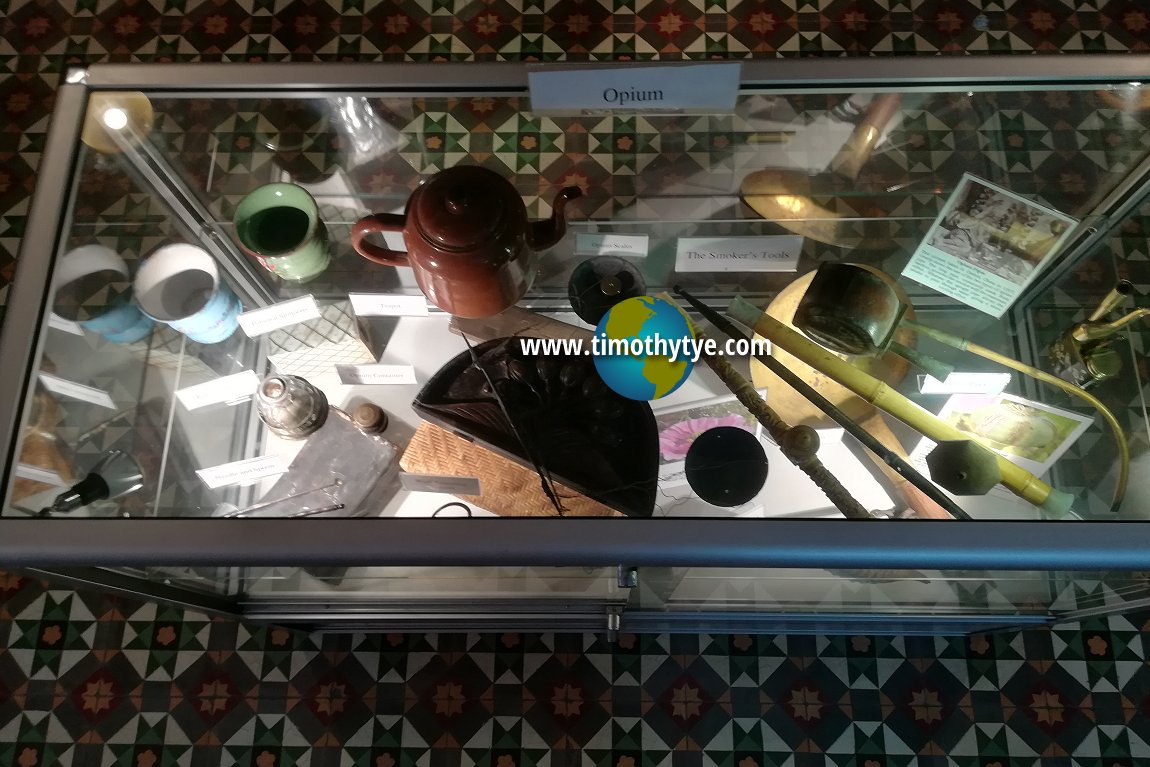 Tools for smoking opium. (3 May, 2016)
Tools for smoking opium. (3 May, 2016)
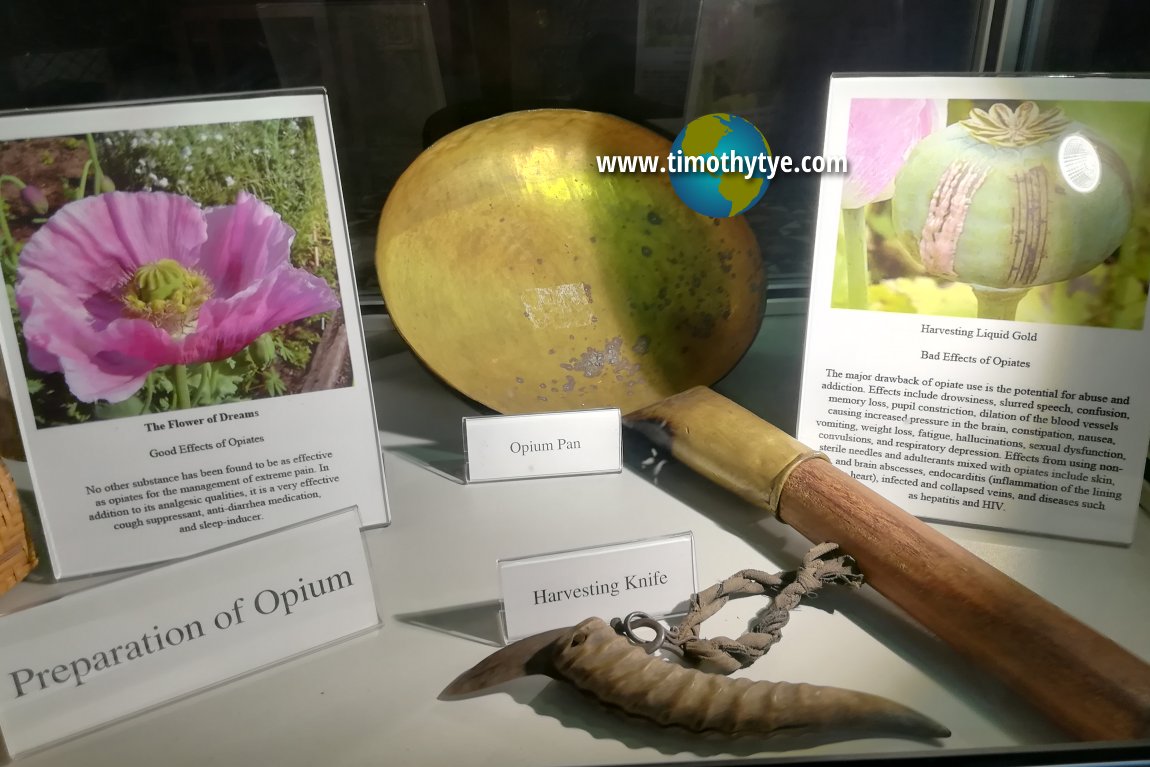 Information on opium, which could be used as a painkiller, but is often abused, leading to addiction. (3 May, 2016)
Information on opium, which could be used as a painkiller, but is often abused, leading to addiction. (3 May, 2016)
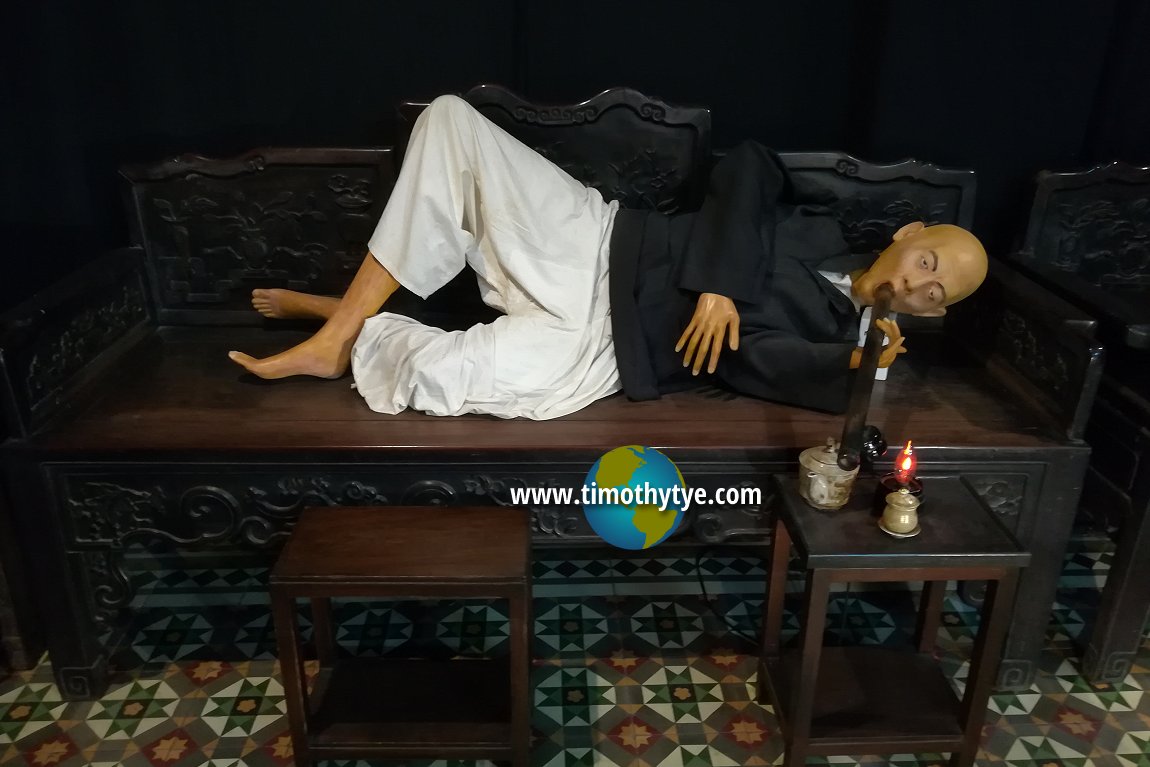 Opium smoker smoking opium on an opium bed. (3 May, 2016)
Opium smoker smoking opium on an opium bed. (3 May, 2016)
 Chinamen gambling in Han Chin Pet Soo. Note the queue - this form of hair style was forced on the Chinese men by the Manchu after they conquered China and established the Qing Dynasty. (3 May, 2016)
Chinamen gambling in Han Chin Pet Soo. Note the queue - this form of hair style was forced on the Chinese men by the Manchu after they conquered China and established the Qing Dynasty. (3 May, 2016)
 Chinese tin miner in a uniform as he had returned from an audience with the Sultan. (3 May, 2016)
Chinese tin miner in a uniform as he had returned from an audience with the Sultan. (3 May, 2016)
 Chinese tin miner in Western costume. This figure actually looks a lot like Kapitan Cina Chung Thye Phin. (3 May, 2016)
Chinese tin miner in Western costume. This figure actually looks a lot like Kapitan Cina Chung Thye Phin. (3 May, 2016)
 The men often brought along their concubines, while Japanese and Chinese prostitutes are on hand to offer entertainment. (3 May, 2016)
The men often brought along their concubines, while Japanese and Chinese prostitutes are on hand to offer entertainment. (3 May, 2016)
 Cards, mahjong and board games were the source of entertainment and gambling for the men. (3 May, 2016)
Cards, mahjong and board games were the source of entertainment and gambling for the men. (3 May, 2016)
 Chinese chess and Chinese card are among the games played at the club. (3 May, 2016)
Chinese chess and Chinese card are among the games played at the club. (3 May, 2016)
 Lodging provided at Han Chin Pet Soo includes chamber pot used as a portable toilet. The resident housekeeper is responsible for emptying it. (3 May, 2016)
Lodging provided at Han Chin Pet Soo includes chamber pot used as a portable toilet. The resident housekeeper is responsible for emptying it. (3 May, 2016)
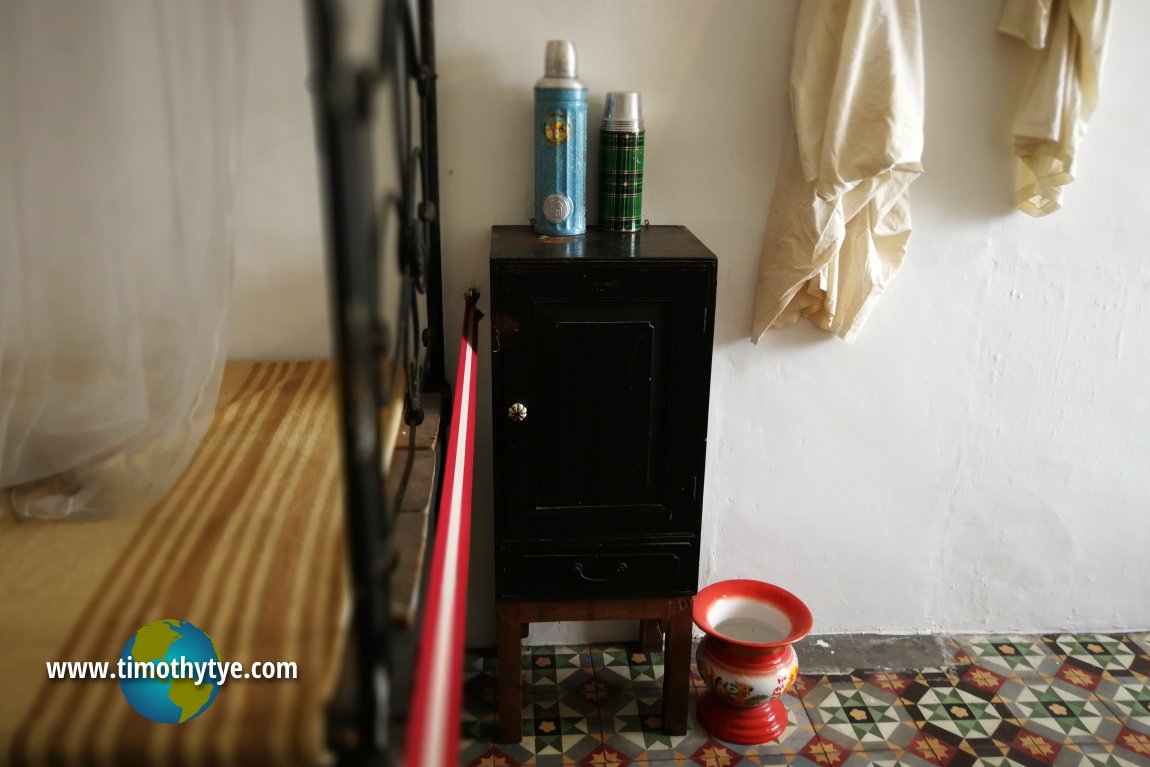 Guesthouse, early 20th century style, includes thermos and spittoon. (3 May, 2016)
Guesthouse, early 20th century style, includes thermos and spittoon. (3 May, 2016)
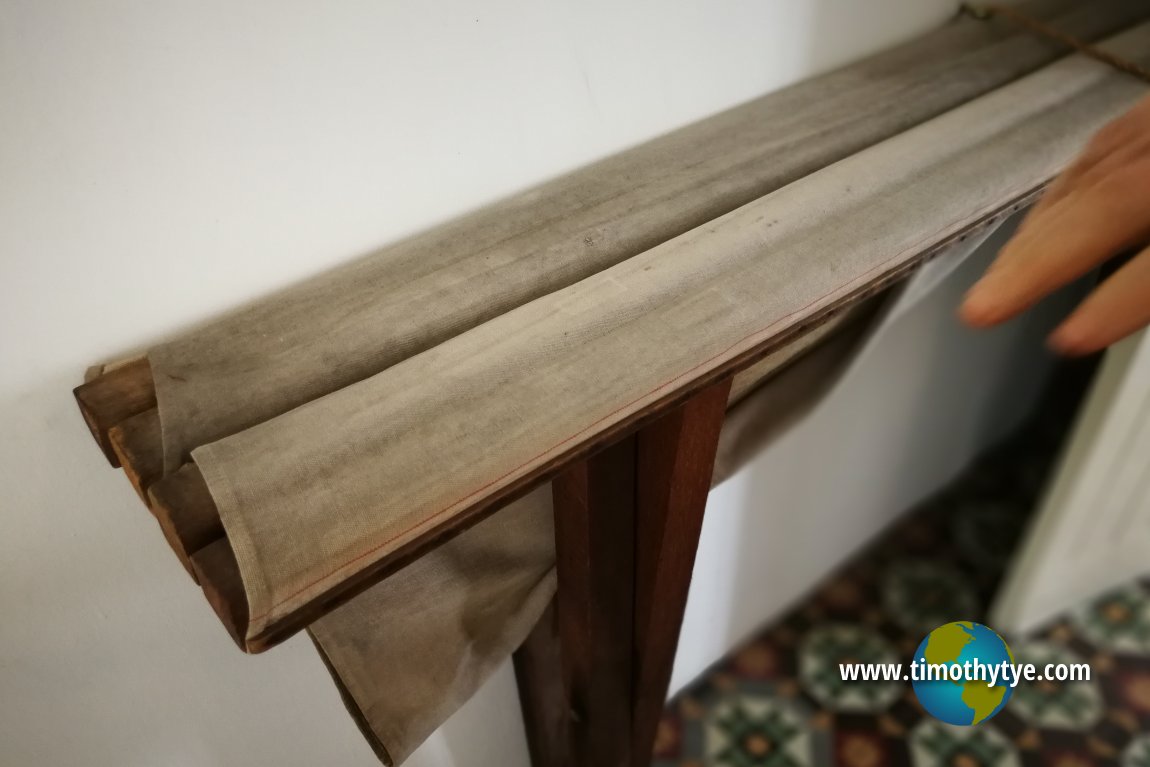 Camp beds are available to accommodate additional house guests. (3 May, 2016)
Camp beds are available to accommodate additional house guests. (3 May, 2016)
Han Chin Pet Soo Video on Facebook
My visit to Han Chin Pet Soo
I visited Han Chin Pet Soo with my wife on 11 March, 2018. We were met by Mr Ian Anderson, who warmly welcomed us into the museum, and took us on an interpretive tour of the exhibits. Mr Anderson has worked tirelessly to document the history of Han Chin Pet Soo, and to present an accurate picture of how it was.Han Chin Pet Soo on Google Street View
Han Chin Pet Soo building before its present restoration. (Apr 2014)Han Chin Pet Soo is  on the Map of Ipoh Old Town
on the Map of Ipoh Old Town
Acknowledgement
I wish to thank Mr Ian Anderson for the help rendered in preparing this article. Ian Anderson and I in front of Han Chin Pet Soo. (3 March, 2018)
Ian Anderson and I in front of Han Chin Pet Soo. (3 March, 2018)
References
- Wikipedia: Han Chin Pet Soo
- Wikipedia: Leong Fee
Back to Discover Ipoh, Perak; list of Museums in Ipoh, Museums in Perak and Museums in Malaysia
 Latest updates on Penang Travel Tips
Latest updates on Penang Travel Tips
 Ipoh Sight Index
Ipoh Sight Index
 Streets of Ipoh
Streets of Ipoh
 Map of Ipoh, Perak
Map of Ipoh, Perak
 Discover with Timothy Ipoh Videos
Discover with Timothy Ipoh Videos
Where to go, what to see when in Ipoh? Here are some suggestions with my videos!About this website

Dear visitor, thank you so much for reading this page. My name is Timothy Tye and my hobby is to find out about places, write about them and share the information with you on this website. I have been writing this site since 5 January 2003. Originally (from 2003 until 2009, the site was called AsiaExplorers. I changed the name to Penang Travel Tips in 2009, even though I describe more than just Penang but everywhere I go (I often need to tell people that "Penang Travel Tips" is not just information about Penang, but information written in Penang), especially places in Malaysia and Singapore, and in all the years since 2003, I have described over 20,000 places.
While I try my best to provide you information as accurate as I can get it to be, I do apologize for any errors and for outdated information which I am unaware. Nevertheless, I hope that what I have described here will be useful to you.
To get to know me better, do follow me on Facebook!
Copyright © 2003-2025 Timothy Tye. All Rights Reserved.

 Go Back
Go Back